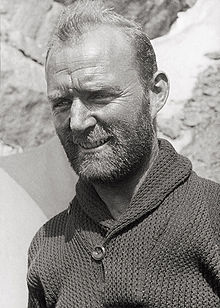Lorenz Saladin
Lorenz Saladin (born October 28, 1896 in Nuglar-St. Pantaleon , † September 17, 1936 in Maida-Adyr, Kyrgyzstan ) was a Swiss expedition mountaineer and photographer .
Life
Saladin came from the simplest of backgrounds, worked in various professions, including as a plumbing fitter, and did border service in the First World War . A passionate mountaineer and climber from an early age , active in the Naturfreunde tourist association , Zurich section and in the Swiss Alpine Club . He was politically active in the KPS ( Communist Party of Switzerland ).
On adventurous journeys between 1920 and 1932 through Europe, South America and the USA, he began to take photographs and developed himself into an excellent photographer.
In 1932 Saladin was a participant in the Caucasus expedition of the Alpine Ski Club Zurich ASCZ. He met the Moscow music student and mountaineer Georgi Charlampiew. Saladin began to publish reports with his own photos in the alpine specialist press and magazines.
In 1934, with Charlampiev's support, he organized his own Caucasus expedition, which achieved great ascents, including the first ascent of the five-thousand- meter peak Mishirgitau .
In 1935 he took part in a geological expedition to the Pamirs organized by the Soviet authorities . There he met the top Russian mountaineers Vitali and Yevgeny Abalakov . Difficult ascents, including Pik Granitnij and the six-thousander Pik Trapez .
In 1936 he traveled back to the Pamirs and explored the Karasuu Valley in the Karavshin area with geologists, among others, as the first Western European, which is now an Eldorado for extreme climbers. Then he travels on to the Tienschan with the goal of Khan Tengri . After bureaucratic difficulties, a long march with horses over the 60 km long Iniltschek glacier , Lorenz Saladin, Jewgeni and Vitali Abalakow, Leonid Gutman and Michail Dadiomow succeeded in the third ascent of the 7,010 meter high Khan Tengri over the west ridge on September 5, 1936.
The expedition was far too late for this time of year on the northernmost and coldest seven-thousand-meter peaks on earth. The descent in a snowstorm turned into a drama, Gutman fell, was seriously injured, material was lost, and nights of bivouac in snow caves followed. All suffered from altitude sickness, dehydration and frostbite. As a result of an infection caused by manipulation of his frostbite with a knife, Saladin died on September 17, 1936 while marching back on the back of a horse at the end of the Iniltschek. His grave was only rediscovered in 2008.
Saladin left a large number of excellent alpine and ethnographic photos from his travels and especially his expeditions, some in stereo. Based on these pictures and extensive research, including in Moscow, the Swiss writer Annemarie Schwarzenbach wrote a biography of Saladin, which was soon out of print. The photos were also lost for a long time. While researching a new edition of Schwarzenbach's book, the authors Robert Steiner and Emil Zopfi found Saladin's photo archive and were able to transfer it from private ownership to the Alpine Museum Bern .
literature
- Annemarie Clarac-Schwarzenbach: Lorenz Saladin. A life for the mountains. Preface by Sven Hedin . Bern: Hallwag, 1938.
- Annemarie Schwarzenbach: Lorenz Saladin, a life for the mountains. Basel: Lenos, 2007.
- Robert Steiner, Emil Zopfi: Death on Khan Tengri. Lorenz Saladin, expedition mountaineer and photographer. Zurich: AS Verlag, 2009.
- Emil Zopfi : He didn't know what fear was , in: Bündner Monatsblatt 5/2010, pp. 470–494. doi : 10.5169 / seals-398959
| personal data | |
|---|---|
| SURNAME | Saladin, Lorenz |
| BRIEF DESCRIPTION | Swiss expedition mountaineer and photographer |
| DATE OF BIRTH | October 28, 1896 |
| PLACE OF BIRTH | Nuglar-St. Pantaleon |
| DATE OF DEATH | September 17, 1936 |
| Place of death | Kyrgyzstan |
